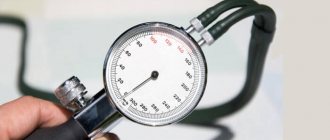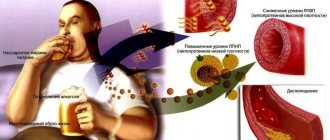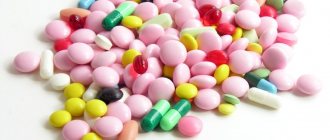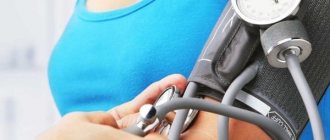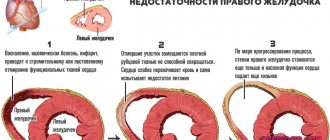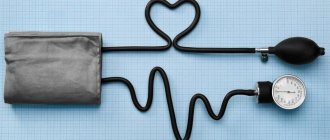A pressure of 150 per 100 tonometer units is the first symptom of developing arterial hypertension of the 1st degree. The causes of the disease can be external factors that negatively affect the human body, as well as the patient’s lifestyle.
These blood pressure indicators are not critical, but despite this they can cause sudden complications such as stroke, myocardial infarction, circulatory disorders in the brain tissue, or provoke the development of dysfunctions of other organs (the kidneys, aorta, and eyeball are primarily affected) .
What is normal pressure and how to measure it correctly
In a middle-aged person, normal blood pressure ranges from 120-129 to 80-84. These limits are average and for some people the normal pressure may be 108-119 per 70-75 or 125-130 per 85-95. Blood pressure can rise to 150/100 in people for various reasons, but to understand that this is a pathology you need to know your usual blood pressure. To do this, it must be constantly monitored by measuring it with a tonometer.
The technique for measuring blood pressure is as follows:
- Sit on a chair or sofa, take a comfortable position.
- Relax and place the blood pressure cuff on your upper arm (just above the elbow).
- Carry out the measurement according to the instructions for your device (press the start button, or inflate the cuff yourself and watch the needle oscillate).
If the pressure is 150 to 100, then calm down and remeasure it after 10 minutes. If it has dropped, then short-term jumps to 150 to 100 could be a sign of stress, and if it persists and calm and relaxation do not help, then you need to look for the cause.
If, after measuring your blood pressure for several days, you see a picture of 151 over 101 or even 158 over 110, then this is a sign of hypertension. There are several stages of pathology:
| Stages of hypertension | Upper pressure | Lower pressure |
| Norm | Up to 130 | Up to 90 |
| Stage 1 | 140- 159 | 90-101 |
| Stage 2 | 160-180 | 102 -110 |
| Stage 3 | Over 180 | Over 111 |
Taking measurements at home is comfortable and convenient, but if there are problems with your blood pressure, then you must see a doctor. This is especially important for people who feel normal with a pressure of 107 over 60, since for them a jump even to 149 over 93 is already a pathology.
Along with your blood pressure, immediately measure your pulse. The frequency of beats per minute can tell you why the pressure has increased to 150 to 100.
What to do if blood pressure is 150/110
Antihypertensive drugs
If your blood pressure is 150/110, you should consult a doctor. The doctor will conduct an examination and draw up a treatment plan according to indications, based on the root cause of the disease.
You can reduce blood pressure to 150/110 with antihypertensive drugs, which are necessarily prescribed by a doctor as part of complex therapy:
- angiotensin-converting enzyme inhibitors - Captopril, Lisinopril, Enalapril: dilate blood vessels, reduce the production of angiotensin 2 enzyme;
- beta-blockers - Atenolol, Prazonin: block nerve impulses that respond to the production of norepinephrine and adrenaline, used to treat diseases of the cardiovascular system;
- calcium antagonists - Amlodipine, Verapamil, Nifedipine: normalize heart rhythm, restore blood supply to the brain, reduce the likelihood of thrombosis;
- diuretic tablets – Hydrochlorothiazide, Diacarb: remove excess fluid from the body, reduce the load on blood vessels;
- peripheral vasodilators - Molsidomin, Sermion: have an antianginal effect, dilate blood vessels, reduce oxygen starvation of the myocardium.
There are many medications for hypertension, the doctor will prescribe the necessary pills
Traditional medicine recipes
You can normalize high blood pressure of 150 to 110 using folk remedies:
- Valerian decoction. To prepare the drink you will need 2 tbsp. crushed valerian root and 500 ml of water. Valerian root is poured with boiling water and cooked on the stove for about 10 minutes. Afterwards, the broth must be removed from the stove and allowed to brew for an hour. Every day you should drink 150 ml of decoction twice a day before meals. The course of therapy is 1 month. If necessary, the course is repeated after a month. A decoction of valerian will help lower blood pressure and get rid of increased anxiety.
- Hawthorn tea. For cooking you will need 2-3 tbsp. dried hawthorn berries, 300-400 ml of water. It is necessary to brew the berries in boiling water and leave for 2-3 hours. It is recommended to drink 100 ml of tea before the main meal four times a day. Course duration is 30-60 days. A repeat course is allowed after a month.
- Chokeberry with honey. To prepare you will need 1 kilogram of chokeberry, a kilogram of sugar, half a liter of honey. The berries are mixed with sugar and left for a couple of hours. Then the mixture needs to be boiled for one and a half to two hours and honey added. After active mixing, the jam should be poured into jars and closed tightly. Jam is eaten after the main meal, 1 teaspoon per day. The duration of the course is 60 days. A repeated course is allowed after 3-4 months.
Non-drug methods
When a person’s blood pressure is 150 to 110, not only the prescription of medications or treatment with traditional medicine is required, but also lifestyle correction. For each patient, the doctor gives individual recommendations:
- moderate consumption of salty foods: no more than five grams of table salt per day;
- dietary nutrition: inclusion of fresh fruits and vegetables in the diet, avoidance of carbohydrate foods and vegetable fats;
- weight loss if you are overweight: excess weight provokes the development of hypertension, as the heart and blood vessels have to work under increased stress;
- getting rid of bad habits: first of all, smoking, alcohol addiction, drug use, tobacco smoking, alcoholic beverages provoke jumps in blood counts;
- increasing active physical activity: you need to regularly do gymnastics in the morning, go swimming, jogging, race walking, doctors advise walking more, relaxing in the fresh air; excessive physical activity can have the opposite effect;
- reducing the impact of stress, a calm reaction to anxiety, reducing the level of anxiety: doctors recommend avoiding stressful situations, and taking mild sedatives of herbal origin for anxiety.
Regularly performing simple exercises will have a beneficial effect on the well-being of hypertensive patients.
If you follow all the recommendations of your doctor, take medications on time, observe the dosage and frequency of administration, you can quickly normalize your blood pressure. With a properly selected treatment regimen, the likelihood of developing a hypertensive crisis, heart and vascular diseases, heart attack, acute cerebral circulatory disorders, and ischemia is significantly reduced.
In case of a one-time increase in blood pressure, provoked by external factors or an incorrect lifestyle, it is recommended to reconsider your habits and eliminate provocateurs. If your blood pressure levels increase regularly, you should consult a doctor. The doctor will conduct an examination, observe the patient’s condition, and then draw up an individual treatment plan. For hypertension, treatment is carried out comprehensively.
Pressure danger 150 to 100
If the pressure is 150 over 100, many people don’t know what to do. First you need to determine why blood pressure rises, what it is connected with and whether there is a risk to health. If the blood pressure has risen in a child or teenager, then medical attention is definitely needed.
Adults often accept this pressure as the norm, and even give it the name “working pressure.” But the consequences of such a negligent attitude towards one’s health can be disastrous. If the indicators remain above 152 to 98 for a long time, this increases the risk of stroke and heart attack.
This pressure is especially dangerous during pregnancy. Women with high systolic and diastolic blood pressure should be constantly monitored by a doctor. It is not recommended for a pregnant woman to take medications on her own, as they can negatively affect the fetus.
Any pressure above normal needs to be brought down. Is it dangerous? Yes, but you should not self-medicate. Constant hypertension is a sign of a disease, and you need to treat it, and not take a pill for blood pressure and forget about it until a new attack occurs.
Ways to lower pressure
To reduce the values, you need to consult a doctor who will prescribe medications, a diet for hypertensive patients, and give general recommendations for preventing the disease. You should not take medications without a doctor's prescription. Medicines have many contraindications and restrictions that can provoke the course of the disease. The drug is selected individually after examination.
If there is a sharp increase, you can reduce the pressure of 150 to 100 to normal values using simple methods. The procedure is as follows:
- We ventilate the room.
- Unbutton the collar and take off tight clothes.
- We lay the patient horizontally: the head should be higher than the legs.
- Take a deep breath and exhale: repeat the procedure for 5 minutes.
- We massage the patient's shoulder, neck and neck area.
- We take a natural sedative: motherwort, valerian infusion.
Medicines that lower blood pressure
To lower your blood pressure, your doctor will prescribe antihypertensive medications. Antihypertensive drugs include:
- angiotensin-converting enzyme inhibitors: block changes in the oligopeptide hormone angiotensin from the first to the second, dilate blood vessels;
- angiotensin II receptor antagonists: dilate blood vessels, remove excess water;
- calcium antagonists: relieve vascular spasms, prescribed for angina pectoris;
- diuretics: remove water, reduce potassium content, increase the lumen of blood vessels;
- Beta blockers: block the release of adrenaline.
The choice of drug depends on the cause. The doctor can prescribe drugs from one group or create a complex to reduce blood pressure.
Methods for correcting high blood pressure
Adjusting nutrition and lifestyle
If you have hypertension, you need to change your lifestyle. A person’s increased blood pressure of 150 to 100 is inextricably linked with diet, bad habits, sedentary behavior, and lack of minimal physical activity.
If there is a risk of developing hypertension, you need to give up salty, fatty, spicy foods, smoked foods, and reduce your consumption of coffee and alcohol. The diet should consist of fresh fruits and vegetables, lean meat, poultry, and fish.
Sleep and physical activity play an important role in normalizing the condition. You need to do exercises in the morning, accustom yourself to sleep at least 8 hours, go to bed before 12 o'clock at night, and not get nervous over trifles.
High blood pressure of 150 over 100 is a sign of second-degree hypertension. If the readings regularly rise to these values, you need to go to the hospital. Self-medication can worsen the course of the disease.
Causes of a one-time jump in blood pressure levels
One-time increases in blood pressure up to 150/100 are quite rare, but there are also reasons for this:
- Under stress, blood pressure surges are a constant occurrence; even after ordinary injections or other unpleasant manipulations, blood pressure may rise.
- Sodium salts delay the removal of water from the body, which leads to poor circulation and increased blood pressure. If you ate a large amount of salt in the evening, you may feel a jump in the morning.
- Those who think that beer and other alcohol lower blood pressure are mistaken. In the first minutes after taking it, the blood vessels expand sharply and the readings drop, but after half an hour a sharp reverse process occurs, due to which the pressure can even jump to 160 to 103 and higher. After drinking with a hangover in the morning, the increase in indicators is noticeable, and additional nausea and headaches only make the situation worse.
- Blood pressure may temporarily increase due to excessive fluid consumption, especially clean water. The load on the kidneys increases, which is why the jump occurs.
With a one-time increase in pressure of 150 to 100, there is no need to panic, the main thing is to restore your usual lifestyle and establish the balance of the body.
What medications are taken for this disease?
When the pressure is 150 over 100, it is necessary to use antihypertensive drugs. At the same time, the doctor must decide what exactly the patient should take.
There are many drugs available to treat hypertension. Each of them has its own advantages and disadvantages. Therefore, it is so important that the doctor prescribes the medicine to the patient.
What tablets are prescribed for a blood pressure of 150 to 100:
- ACE blockers. These drugs block the conversion of inactive angiotensin-1 to the vasoconstrictor angiotensin-2. In addition, the product stimulates processes that promote vasodilation. This drug can be taken by diabetics and those who have heart problems.
- Angiotensin-2 receptor inhibitors. This remedy helps normalize blood pressure by preventing vasoconstriction and having some diuretic effect.
- Calcium channel blockers. Prevents vasospasm and helps cure certain diseases. This drug is also used to treat angina pectoris.
- Diuretics. They have a diuretic effect and reduce potassium concentrations. Due to this, the vascular lumen increases and pressure decreases.
- Adrenergic blockers. They block the action of adrenaline, which increases blood pressure.
Causes of long-term persistent increase in blood pressure levels
Hypertension is rarely an independent disease; it is often the second way pathology manifests itself in the body. In men and women, constant high blood pressure occurs to the same extent, and the reasons for its increase are as follows:
- Hypercortisolism - the adrenal glands produce an increased amount of cortisol, which directly affects the tonometer readings. Itsenko-Cushing is a disease that is accompanied by this pathology and, as a symptom, a person has elevated tonometer readings on an ongoing basis.
- Tumors in the pituitary gland or hypothalamus.
- Neoplasm in the thyroid gland, hyperthyroidism.
- Osteochondrosis of the spine at the cervical level. Due to improper regulation and not always received impulses, a person’s blood pressure can fluctuate. It either decreases, or increases, or is constantly outside the norm on one side.
- Atherosclerosis. Why do you feel the pressure increase? The blood vessels become clogged and the blood circulates at different rates, causing blood pressure to change and blood clots to appear.
- Any endocrine diseases. Even diabetes can contribute to surges or persistent increases in blood pressure.
- Nephritis of various etiologies directly affects the circulatory system and blood pressure regulation. If left untreated, there is a risk of malignant hypertension.
The search for the causes of high blood pressure should be carried out by a doctor, having studied the tests and examinations of the person. There is no need to blame it on age and treat yourself with folk remedies; you need to eliminate the cause.
Symptoms
In the initial stages of the disease, there are no symptoms. In addition to increased blood pressure, the following are possible:
- migraine;
- increased heart rate and pulse;
- drowsiness, weakness;
- dark circles under the eyes;
- swollen eyes;
- vomit;
- bad dream.
With a constant increase in pressure, a dangerous hypertensive crisis can develop, which is accompanied by:
- intestinal disorder;
- poor ability to see;
- heavy sweating;
- numbness of the limbs.
All these manifestations are a sign of cerebral vascular spasm and require immediate attention to a medical facility. In men and women, high blood pressure is expressed differently:
- Men are characterized by irritability, severe headaches in the back of the head, profuse sweating and nosebleeds.
- Representatives of the fair sex experience redness of the skin, stress, nervousness, and fatigue. As the severity of the disease increases, feelings of nausea, heart pain, rapid pulse and nosebleeds appear.
If the patient's blood pressure is 150 over 100, it is alarmingly high, you should consult a doctor to prevent a hypertensive crisis.
Is a reading of 150/100 dangerous during pregnancy?
Young girls and older women in pregnancy should closely monitor any changes in the body. In the early stages of pregnancy, a woman may not feel any problems, but as the fetus grows, the pressure on the kidneys increases, which can cause the pressure to jump. Other diseases may manifest themselves or intensify against the background of an “interesting” situation; a doctor should work here.
But if initially the normal blood pressure fluctuated between 140 and 90, then a slight increase is normal. But for ladies with the usual 110 to 70, this is a problem. If you have high blood pressure, taking pills on your own is dangerous, so you should seek advice.
Which doctor should I contact?
When the first signs of high blood pressure appear, you should visit a therapist; he will provide treatment at the initial stage of hypertension. At later stages of pathology development, therapy is carried out by a cardiologist, nephrologist, neurologist; the choice of a specialist depends on which organs are affected during the progression of the disease.
In the later stages of hypertension development, you may need help from a cardiologist.
Symptoms requiring consultation with a specialist
Reasons for contacting a specialist in addition to high tonometer readings:
- Headache with regular intervals. If the back of the head, forehead or temporal region hurts, it is necessary to check for diagnosis.
- Attacks of dizziness that recur daily.
- The person feels sick, then vomits, but it does not bring relief.
- Breathing becomes difficult even at rest.
- Visual impairment – blurred vision, fog before the eyes.
When the pressure is 150 over 100, only a doctor can tell you what to do. He will tell you how to reduce indicators if they bother a person every day. But before prescribing the medicine, he will interview the patient about accompanying symptoms.
Peculiarities
Before answering the question of how to reduce a person’s blood pressure from 150 to 100, you first need to figure out what pressure is considered normal. Now readings within 120/80 do not cause concern (small errors are acceptable, this can be attributed to age or occupation, for example, you should not be afraid of readings at 130/90).
If the numbers tend to go up, this is already considered a deviation, for example, in the case when the tonometer needle indicates 150/100, you should pay close attention to your body, as this is a bell about the hidden first stage of hypertension.
But there is no need to panic right away. Various circumstances may arise in life that temporarily increase blood pressure, for example, stress at work. And also, we should not forget that before measuring readings, you must be at rest, properly fix the device on your hand, and remain quiet during the measurement procedure. Only in this case the readings should be considered correct.
But if the indicator 150/100 lasts for several days in a row or was noticed more than 3-4 times a week, a visit to the doctor should not be postponed, because the sooner the correct treatment is prescribed, the lower the health risks in the future.
There are cases when elevated readings can warn of the presence of operable or inoperable tumors.
Symptoms requiring immediate emergency medical attention
It is necessary to call an ambulance when the pressure is accompanied by the following symptoms:
- Chest pain, accompanying tachycardia.
- Blurred vision, which is accompanied by speech impairment and the inability to control the facial muscles, are symptoms of a stroke.
- Sharp pain in the back that does not subside.
Do not try to use nitroglycerin or other home remedies to lower your blood pressure. This may not eliminate the symptom, but may only make it worse. If the pressure remains at 150 over 100 and the pills do not help, and the above-described symptoms also appear, calling an ambulance is the only option.
Main causes in men and women
Hypertension is increasingly becoming a problem for modern people. Pathology can occur in both adults and young people, so many have begun to think about the causes of this disease.
The most common factors for the progression of first-degree hypertension include:
- Genetic predisposition. In many people, hypertension is inherited at the genetic level. The disease can be triggered by one of the risk factors, for example, consumption of salt in large quantities. A healthy lifestyle can help you avoid this scourge.
- Nutrition. Unhealthy food becomes another factor in increasing blood pressure. Consumption of large amounts of salt in the daily diet causes early hypertension in 60% of patients. Also, blood pressure begins to jump in people who are on a diet, which leads to an increase in cholesterol levels in the blood. When food is consumed in large quantities, an increase in body weight occurs, which negatively affects the functioning of internal organs. The vessels are pinched and blood slowly flows to the organs. In any case, spicy and fried foods will lead to a blood pressure of 150/100 or higher.
- Age. Most often, the initial stage of hypertension is diagnosed in men over 40–45 years of age. By the age of 55, the likelihood of developing the disease in both sexes increases sharply, because the blood vessels age and lose elasticity.
- Low physical activity is one of the precursors of high blood pressure. Many people with this lifestyle and sedentary work quickly develop hypertension. Sitting at a computer for a long time, constant stress and tension at work are fertile ground for the development of the disease.
- Smoking and alcohol. These bad habits negatively affect the elasticity of blood vessels and destroy the entire hematopoietic system. Tobacco and alcohol quickly destroy a person’s health and cause heart attacks and strokes.
- Pathology. Some internal diseases stimulate increased blood pressure. For example, disruption of the heart muscle, intervertebral hernia, oncology, thyroid disease, kidney disease, diabetes mellitus and atherosclerosis.
- Pregnancy. During the period of bearing a child, women often complain of increased blood pressure, this is due to a huge restructuring of all body functions. If the pressure is very high, then this is very dangerous for the mother and child, since the walls of the blood vessels are compressed, and the flow of nutrients and oxygen to the baby is disrupted, slowing down its development and growth. Hypertension provokes early labor, bleeding, and miscarriages. This is an important diagnostic factor for gestosis in pregnant women.
Maintaining a healthy lifestyle and giving up bad habits will reduce the risk of hypertension progression.
How to reduce blood pressure 150 to 100 at home
You can lower your blood pressure yourself only with light medications in tablet form. Corvalol or Valocordin are perfect. Alcohol tinctures are not recommended. If your doctor previously prescribed Andipal and Clonidine for your blood pressure, you can take them as prescribed.
First-line drugs to quickly lower blood pressure can be dangerous. It is better to consult a doctor before taking it.
If light medications do not help, the lower bar is above 104, and the upper bar is 153, then you should visit a cardiologist or therapist. The doctor will prescribe medications and find out the cause of the illness.
Failure in the body or diagnosis?
So, you saw 150/110 on the tonometer. Any fluctuation in values reflects the result of exposure to external or internal factors on the body. But does this always indicate the presence of arterial hypertension? No, but only if this episode is one-time, and you did not use drugs that can increase blood pressure levels. These include:
- some herbal remedies: eleutherococcus, ginger, ginseng, licorice root, hawthorn, black tea;
- groups of drugs with hypertensive properties: glucocorticoids, combined oral contraceptives, alpha and beta adrenergic agonists, non-steroidal anti-inflammatory drugs, tricyclic antidepressants, erythropoietin, cyclosporine;
- alcoholic and caffeinated drinks;
- Stress factors (emotional background, lack of sleep, violation of daily routine and nutrition, hypovitaminosis) are also related to the regulation of vascular tone and episodes of high blood pressure.
If your pressure, when measured three times, is over 140 to 90 mmHg. Art. and you did not take medications that would affect its increase, we are talking about a chronic disease - arterial hypertension.
Consider a blood pressure level of 150 to 110 mm Hg. Art. Its upper value (systolic indicator) indicates the first degree of the disease, the lower value (diastolic indicator) indicates a transition from the second to the third degree. A predominant increase in diastolic pressure indicates an increased tone of the general peripheral resistance and high tension in the vascular wall at the moment of relaxation of the heart muscle. This form may indicate symptomatic hypertension in nephropathy (when increased pressure is a secondary phenomenon in pre-existing kidney disease).
Treatment with drugs
There are several groups of medications that are good for lowering blood pressure. Only a specialist can tell you which pills to take; you shouldn’t buy them yourself. Highlight:
- Calcium antagonists – Diltiazem.
- Diuretics – Torasemide.
- Beta blockers – Bisoprolol.
- Angiotensin receptor blockers - Losartan.
- ACE inhibitors – Enalapril.
- Alpha adrenergic blockers – Urorek.
Any drug must be used according to the instructions or doctor's orders. Take the full course, and do not stop treatment after the first improvement.
Pulse
Everything in our body is interconnected, which is why high blood pressure increases the heart rate. This rule only works in the absence of other heart diseases.
A pulse of 110 beats per minute indicates that you have tachycardia. What does it mean? Rapid heartbeat has a negative effect on the oxygen saturation of the heart, which can lead to ischemia, and the risk of blood clots increases significantly. Be sure to report this pulse to your doctor, he will correct your treatment.
Irregular heart rhythm is not a sign of high blood pressure!
Non-drug therapy
If hypertension has not become chronic, then folk remedies can help. The most popular decoctions are:
- Motherwort.
- Hawthorn.
- Dennika.
- Melissa.
If you have VSD or other chronic pathologies, then you need to be careful with herbs. Don’t rely on reviews from your relatives, but look at the characteristics of your body and read contraindications.
With a one-time increase in pressure, breathing exercises will help you. Take a sitting position and take 10 deep breaths. This will help reduce blood pressure by 10-20 units. The ear massage also worked well. Rub them in different directions until they become red, but do not overdo it so that it does not hurt. This will change the blood flow and reduce the tonometer readings.
Self-massage at certain points is also useful for eliminating the symptoms of hypertension:
- Massage the point between the index and thumb of your right and left hands alternately.
- Apply pressure to a point just above your elbow when your arm is bent. Massage in circular motions for 5 minutes.
- Massage the middle of your foot for a couple of minutes.
- The point two fingers below the knee is also responsible for blood pressure. Massage it for five minutes.
Additional measures to reduce pressure when it is at around 150 to 100:
- Baths with lavender oil and table or sea salt are good for relieving fatigue, relaxing and lowering blood pressure. 2-3 procedures per week for 20 minutes are enough.
- Proper nutrition and a healthy lifestyle. Do not overeat, especially at night, do light sports or exercise, monitor the balance of carbohydrates, fats and proteins, and a sufficient amount of vitamins.
- Garlic boiled in milk. Drink half a glass three times a day.
- Reduce salt consumption, it is advisable to add only pinches of it to prepared dishes.
- Quitting smoking and drinking alcohol.
- Fight obesity - diet food prescribed by a specialist and moderate physical activity.
- A course of physiotherapy on the advice of a doctor.
Treatment
The initial stage of hypertension is steadily stabilized or completely cured if there are no additional or irremovable risk factors that provoke the disease (stress, excess weight, physical inactivity, smoking, diet disorders) and concomitant diseases of the heart, kidneys, blood vessels (including the brain).
Most people with high blood pressure turn to doctors at moments when hypertension affects target organs (the most sensitive to changes in blood pressure, for example, the retina of the eye, kidneys), and a complex of symptoms appears (headaches, tinnitus). At such stages, a complete cure for hypertension is almost impossible; the main task of the doctor and drug therapy is how to keep the pressure within certain limits and how to reduce the risk of complications in the form of strokes, heart attacks, and sudden death.
Treatment of the initial stages of hypertension includes two mandatory stages: non-drug treatment and medication.
If hypertension is not treated in time, it can lead to harmful consequences for the body (they are listed in the photo)
Non-drug therapy
The non-drug stage of treatment is aimed at eliminating risk factors that could play the role of a “trigger” mechanism:
- Reducing excess body weight in obese people.
- Salt-free diet (for this you need to reduce the amount of salt to 4.5 grams per day).
- Elimination of physical inactivity (do therapeutic exercises, yoga).
- A diet with a minimum content of fatty, fried foods, animal fats and protein. You need to include foods rich in potassium in your diet.
- Complete cessation of nicotine and alcohol.
- Reducing vascular tone with the help of physiotherapeutic procedures (laser therapy, herbal medicine).
To get rid of stress as a possible cause of the disease, doctors recommend sessions of psychological relaxation or psychotherapy. In some cases, it is at this stage that improvement occurs, and drug treatment is no longer required.
Drugs
Drug therapy is selected in the initial stages, if the condition does not improve, pressure surges are regularly repeated or increase to numbers of 150 to 110. The goal of drug therapy in this case is to reduce blood pressure and prevent the risk of complications.
The following groups of antihypertensive drugs are most effective:
- ACE inhibitors (captopril, ramipril, enalapril);
- adrenergic blockers (prazosin and metoprolol);
- calcium antagonists (amlodipine, nifedipine);
- angiotensin receptor antagonists (losartan);
- diuretics (indapamide, hypothiazide)
The doctor selects all medications individually, taking into account gender, age, risk group the patient falls into, concomitant diseases and even social status, regularly monitoring the manifestations of hypertension for 1–2 months.
Captopril is one of the most popular drugs against hypertension
